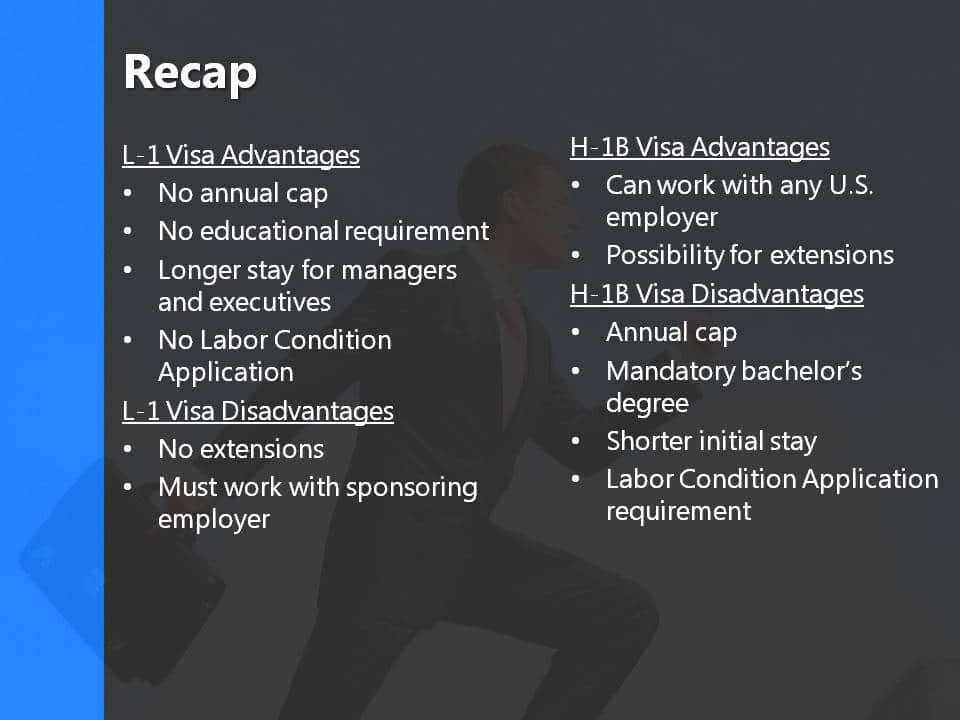L1 Visa for Investors
Some Ideas on L1 Visa You Should Know
Table of Contents4 Simple Techniques For L1 VisaL1 Visa - TruthsNot known Incorrect Statements About L1 Visa L1 Visa - An OverviewFacts About L1 Visa UncoveredSome Known Facts About L1 Visa.The 6-Minute Rule for L1 Visa
The L-1 visa is an employment-based visa classification established by Congress in 1970, permitting multinational firms to transfer their managers, execs, or essential personnel to their united state procedures. It is frequently referred to as the intracompany transferee visa. There are 2 main types of L-1 visas: L-1A and L-1B. These types are ideal for workers hired in different settings within a company.Furthermore, the recipient needs to have functioned in a managerial, exec, or specialized employee setting for one year within the 3 years coming before the L-1A application in the international company. For brand-new workplace applications, international work needs to have been in a supervisory or executive capacity if the beneficiary is pertaining to the United States to work as a supervisor or exec.
for up to seven years to look after the operations of the U.S. affiliate as an exec or manager. If released for a united state company that has been operational for greater than one year, the L-1A visa is at first granted for up to three years and can be prolonged in two-year increments.
The Ultimate Guide To L1 Visa
If given for an U.S. company operational for more than one year, the initial L-1B visa is for approximately 3 years and can be expanded for an added 2 years. Conversely, if the united state firm is recently established or has been operational for less than one year, the initial L-1B visa is released for one year, with expansions readily available in two-year increments.
firm. The optimum keep enabled by each visa also varies. L-1A visa owners can remain in the U.S. for up to seven years, while L-1B visa owners can operate in the U - L1 Visa.S. for up to five years. L-1A visa can result in an EB-1C immigrant visa, whereas L-1B visa can not lead directly to irreversible home status.


Conversely, if you have unique or advanced understanding within your company, you might be eligible for transfer to the U.S. to apply your specialized abilities. The L-1 visa process entails complex procedures, demanding detailed documentation and cautious scrutiny of legal needs on a case-by-case basis. In this regard, the assistance of an immigration attorney is vital for ensuring the successful completion of the procedure.
The L-1 visa stands as an essential tool for international companies, helping with the transfer of crucial employees between overseas and United state branches. To lose light on this subject, we have actually compiled an extensive overview attending to the most frequently asked questions L1 Visa requirements regarding the L-1 visa: At its core, the L-1 visa enables international business to move certain workers from foreign offices to U.S.
entities, such as parent, subsidiary, or affiliate - L1 Visa. Specialized expertise refers to know-how or expertise of the firm's items, solutions, procedures, or treatments that is not easily offered in the U.S.
L1 Visa - Truths
Yes, L-1 visa holders can bring their spouses and partners children under 21 years of age to the United States on L-2 visas.
Citizenship and Migration Provider (USCIS), together with supporting documentation explore your L1 Visa showing the qualifying partnership in between the overseas and U.S. entities and the qualifications of the worker being transferred. While the L-1 visa is a popular option for intra-company transfers, there are alternate visa alternatives offered depending on the individual's credentials and conditions.
Yes, partners of L-1 visa holders on L-2 visas are authorized to work without having to request job consent. While there is no specific need for L-1 visa holders to keep an international house, they are anticipated to maintain ties to their home country and plan to leave the USA upon conclusion of their accredited remain.
The domestic employee needs to have been utilized by the L-1 visa holder for a minimum of one year within the preceding 3 years and need to intend to function full-time for the visa holder in the united state. When requesting an expansion of remain on an L-1 visa, companies should remain to show the qualifying partnership between the abroad and U.S.
The Only Guide to L1 Visa

These needs and interpretations ensure that the L-1 visa program offers its designated purpose of assisting in the transfer of crucial employees within international business while preserving the honesty of the visa classification. L-1B visa owners (specialized expertise workers) can likewise expand their visas in two-year increments, however they are restricted to a five-year stay. An employee that receives the L-1 visa may additionally bring a spouse and dependent kids (unmarried and under 21 years of age) for the visa term.
If a firm fails L1 Visa attorney to file an extension of the covering request in a timely way, it does not cause a three-year waiting duration before one more covering application can be submitted. This permits companies to preserve their blanket L-1 condition a lot more quickly. Lots of L-1 visa owners consider long-lasting potential customers in the USA, and an usual inquiry emerges concerning transitioning to irreversible residency.
L-1A visas are made for managers and executives, while L-1B visas are for workers with specialized understanding, as established by the USCIS. L-1A visa holders commonly have a lot more senior duties within the company, looking after departments or running operations. L-1B visa holders possess thorough knowledge of the firm's special methodologies, items, or solutions.
Not known Factual Statements About L1 Visa
Both visa types are originally provided for one to three years, with the opportunity of extensions in two-year increments. Yes, spouses of L-1 visa owners (L-2 visa owners) are granted job authorization occurrence to status. This suggests they no more require to file a different application for work consent to function in the United States.